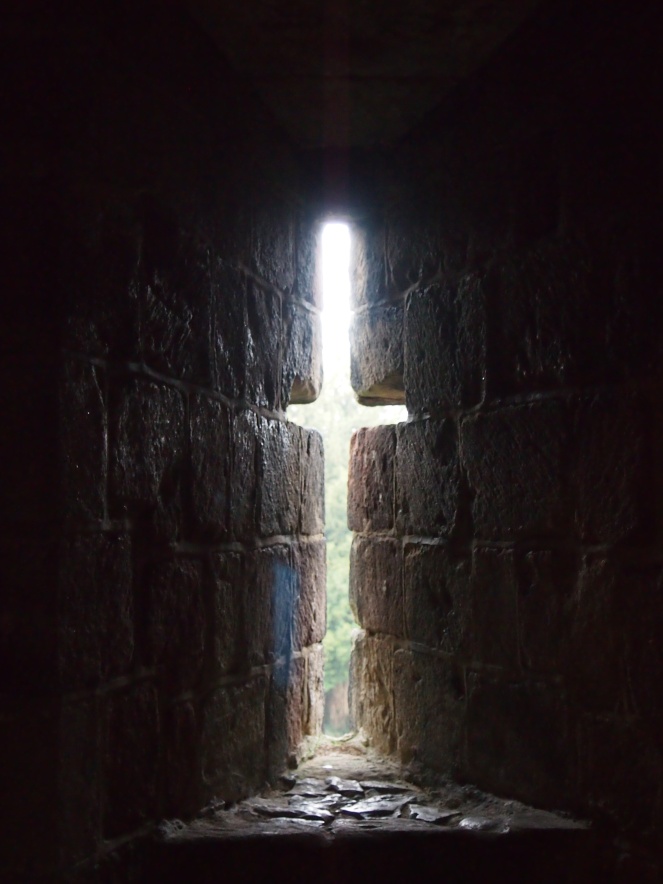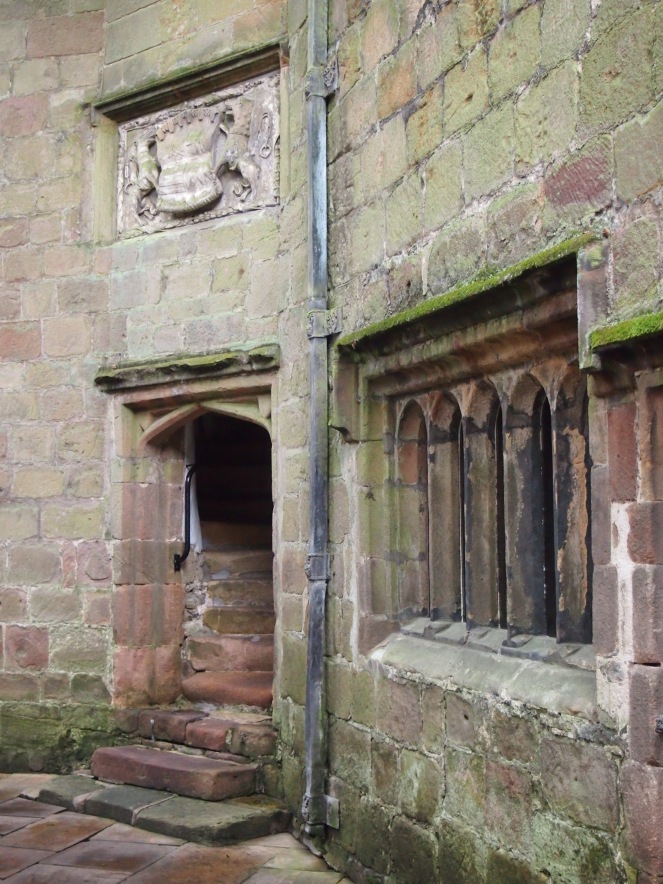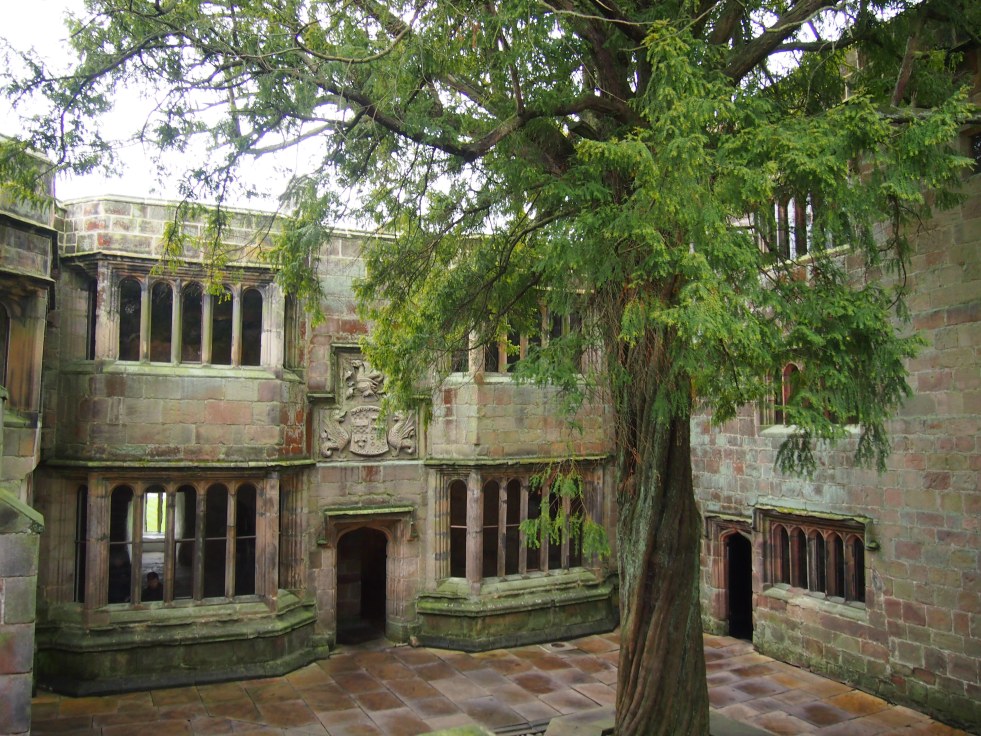It may not be the first place that springs to mind when one thinks of England’s great castles, but in the North Yorkshire town of Skipton a fine medieval castle dominates the skyline. Skipton Castle, the earliest parts of which date from the Norman period, is one of the best preserved castles still standing in England. Visitors can pass through the impressive drum-towered gatehouse to explore a fascinating building that was home to many figures involved in pivotal events during the medieval period, and that owes much of its appearance today to a formidable lady who lived there in the 17th Century.

Skipton Castle was originally constructed as an earth and wood motte and bailey structure in 1090 by Robert de Romille. Romille was a native of Brittany who had come over to England with William the Conqueror’s Norman forces in 1066, and in 1086 was awarded lordship of the estate of Bolton Abbey, which included Skipton. Romille chose the rocky outcrop in Skipton for the site of his castle due to its easily defensible position, and in time the castle became an important defence against possible Scottish invasions. To make the structure more formidable, it was rebuilt in stone.
The picture below shows the view from the back of the castle, over a sheer drop, with a river far below. This north-facing side of the castle was easy to defend – too high up for its walls to be scaled by enemy soliders, and probably out of the range of many siege weapons too.

The south side of the castle, with the large gatehouse pictured below, looked out over the town of Skipton from a lofty vantage point. The distinctive stout towers of the gatehouse were built in the late 12th Century. The motto “Des Or Mais” in Norman French that adorns the top of the gatehouse means “Henceforth”.

Skipton Castle passed back to the crown after the Romille family line became extinct. The castle was briefly held by Piers Gaveston, Edward II’s favourite (or, as one historian writing in the 19th Century described him, his “minion”) in 1308, but after Gaveston’s fall from grace the king granted the castle to Robert de Clifford. At the same time, Clifford was bestowed as the hereditary Sheriff of Westmorland. Clifford was a prominent soldier at the time, and ordered the castle to be strengthened – however, before this work was finished he was killed at the Battle of Bannockburn in 1314. Robert de Clifford’s son Roger succeeded his father as Lord of Skipton, but was hanged in 1322 after being a part of the rebellion against Edward II and the Despenser family. It wasn’t until 1327 that Skipton Castle was restored to the Clifford family, with Roger’s younger brother Robert becoming the third Lord of Skipton.

The photograph above shows just how thick the walls of Skipton Castle are – strong walls were one of a stone castle’s most important defences, and Skipton Castle’s round towers were much harder to undermine than any square or rectangular tower which would have been vulnerable at the corners.

Narrow arrow-slits allowed archers to shoot at besieging troops without themselves being vulnerable to enemy arrows or cannon fire.

The coat of arms pictured below belonged to a member of the Clifford family who was known as the Butcher. John Clifford, the 9th Baron de Clifford, was one of the supporters of Henry VI and his wife Margaret of Anjou during Wars of the Roses. John earned his grim nickname for the killing of Edmund, the young Earl of Rutland, who he killed (or ordered to be killed) after taking the young earl captive following the Battle of Wakefield in 1460. John, like his forebear the first Baron de Clifford, was killed in battle – at Dintingdale in 1461. It was not until the Tudor victory in 1485 that Skipton Castle and the other Clifford lands and property were returned to the Clifford family.

In 1536, a new wing was added to the castle for the bride of Henry Clifford, Lady Eleanor Brandon. Lady Eleanor was the daughter of Charles Brandon and Mary Tudor, and a niece of King Henry VIII. This marriage caused Henry Clifford to become impoverished, probably in part due to the construction of the grand new wing at Skipton. This part of the castle is now a luxurious private residence.

The loveliest and most surprising thing about Skipton Castle is what awaits the visitor after they walk through the castle’s old Norman entrance. Beyond this entrance is Conduit Court, surrounded on all sides by castle buildings that date from the Tudor period and dominated by a huge yew tree. Compared to the castle exterior, with its narrow windows and arrow-slits, the rooms facing the courtyard have large windows that would have let in much more light – being on the inside of the castle there was no need for the windows here to be kept small and defendable. The courtyard gets its name from the water supply that was piped into the castle, which terminated in the courtyard.


Various doors and staircases lead off Conduit Court to different parts of the castle – some, like the Great Hall, were spaces where the Lord of the castle would entertain visitors; others were rooms used by the many servants and soldiers who lived there.




Skipton Castle as we see it today owes a great deal to one remarkable woman, Lady Anne Clifford.

Anne was the only daughter of George Clifford, 3rd Earl of Cumberland, who was the Queen’s Champion and a swashbuckling figure at the court of Elizabeth I. Anne’s two brothers both died young, and when George died in 1605, the title of Earl of Cumberland, and all of the family’s lands and property, passed to George’s brother Francis – George felt that his possessions were better off in the hands of his adult brother rather than his teenage daughter. Despite challenging her uncle’s claim to the estate, Anne did not inherit Skipton Castle and the other Clifford estates until 1643, following the death of her cousin Henry. Anne’s mother Margaret, a close friend of Queen Elizabeth I, had been a patron of literature, and Anne followed in her footsteps by supporting various artists and authors – she was also a prolific diarist and letter-writer.

Not long after Lady Anne had inherited Skipton Castle, the English Civil War broke out. Fierce fighting between the Royalists and Parliamentarians laid waste to many of England’s medieval castles, and in 1642 Skipton Castle, the last Royalist stronghold in the north of England, found itself under siege.
This siege was to last three years. A hidden well was recently discovered near what is now the castle’s cafe and gift shop – it’s believed that it was this well that kept the castle supplied with fresh, clean water during the long siege. Local legend tells that sheep fleeces were hung over the castle walls during the siege to reduce the damage inflicted by Parliamentarian cannon fire. Whether or not this tale is true, it has resonated enough over the years for the town’s coat of arms to feature sheep fleeces.

In the end, a surrender was negotiated in 1645 and the Royalist forces were permitted to march out of the castle. A brief reoccupation of Skipton Castle in 1648 by Royalist troops caused Oliver Cromwell to order the castle roof to be destroyed, to prevent it being a useful and defensible stronghold in the future.
Skipton Castle escaped the total destruction that was the fate of many contested castles during the civil war, but nonetheless it was severely damaged. Lady Anne Clifford set to work repairing and restoring the castle, receiving special permission from Lord Protector Oliver Cromwell to carry out the repairs, under the condition that the roofs and walls were deliberately made so that they were not strong enough to support cannons. This condition was in place as Cromwell did not want the castle to have the potential to become a Royalist stronghold again.
As well as restoring Skipton Castle, Lady Anne worked hard to restore and improve many other properties and churches on her estates, including the parish church of Skipton, where her father and brothers are buried, and castles at Appleby, Pendragon, Brough and Brougham.

The plaque above the door reads:
THIS SKIPTON CASTLE WAS REPAYRED
BY THE LADY ANNE CLIFFORD, COVNTESSE
DOWAGER OF PEMBROOKEE, DORSETT, AND
MONTCOMERY, BARONESSE CLIFFORD, WEST
MERLAND, AND BESELE, LADY OF THE HONOR
OF SKIPTON IN CRAVEN AND HIGH SHERRIFF
ESSE BY INHERITANCE OF THE COVNTLE,
OF WESTMORLAND, IN THE YEARES 1657
AND 1658, AFTER THIS MAINE PART OF ITT HAI
LAYNE RVINOVS EVER SINCE DECEMBER 16
48, AND THE JANUARY FOLLOWINGE, WHEN
ITT WAS THEN PULD DOWNE AND DEMOL
ISHT, ALLMOST TO THE FOVNDACON, BY THE
COMMAND OF THE PARLIAMENT, THEN
SITTINGE AT WESTMINSTER, BECAVSE
ITT HAD BIN A GARRISON IN THE THEN
CIVILL WARRES IN ENGLAND. ISA, CHAP.
58, VER. 12. GODS NAME BE PRAISED.
The yew tree in the Conduit Court, with its elegantly twisting trunk, is thought to have been planted by Lady Anne in 1659 to commemorate the completion of the castle’s restoration. Lady Anne was the last Clifford of Skipton Castle. After her death in 1676 at the venerable age of 86, the castle and the other Clifford estates went to the Earls of Thanet, descendents of one of her daughters.


Within the castle walls is the ruin of a 13th Century chapel. Dedicated to St John the Evangelist, this chapel was used by the inhabitants of the castle for many centuries, although its proximity to the local parish church meant that no burials took place in the chapel. It’s thought that it fell out of use during the Civil War, and after that it was used as a stable.

In recent years, the old chapel has undergone some restoration, with the original windows being carefully reconstructed by skilled stonemasons.

Today, Skipton Castle is a popular visitor attraction. Its warrens of well-preserved rooms are great fun to explore and the illustrated tour sheets and information plaques in each room bring the empty spaces to life. The beautiful Conduit Court is an absolute gem and it is testament to the resource and care that Lady Anne Clifford provided when restoring Skipton Castle that it still looks so magnificent today.
Visitor information can be found here.

References and further reading
Guide to Skipton Castle, purchased at the castle
Tour sheet provided to visitors of the castle
Skipton Castle – A History of Skipton Castle http://www.skiptoncastle.co.uk/hist.asp?page=3
Lady Anne Clifford, in An Inventory of the Historical Monuments in Westmorland, 1936 http://www.british-history.ac.uk/rchme/westm/lv-lvii


Reblogged this on First Night History.
LikeLike
Amazing pictures and highly informative. Thanks for sharing.
LikeLike
Thank you!
LikeLike
Wow. Castles.. Gives me memories.
LikeLike
Thanks!
LikeLike
What a wonderful post, Susan and great pictures. Your story brought the castle to life.
LikeLike
Thank you!
LikeLike
Fantastic, Caroline! I really enjoyed reading this, and seeing your photos. What an incredible place, and I love Conduit Court and the old yew tree especially. I also like the story of the fleeces being hung over the walls to reduce damage from cannon fire – I can imagine that might have worked! What a determined woman Anne Clifford must have been. I have visited one of the other places she had restored – Barden Tower, also in Yorkshire, but not nearly as big or impressive as Skipton.
LikeLike
I hadn’t been aware of Anne Clifford before visiting Skipton Castle – she was quite a remarkable woman. I especially love the yew tree she planted – I love how its trunk twists around as it goes up.
LikeLiked by 1 person
Very interesting and gorgeous photography. This is my first visit, but I will be back. Thank you!
LikeLike
Thank you very much!
LikeLike
Reblogged this on Amy Quinton and commented:
Wow – Just wow…
LikeLike
Fascinating. Thank you so much for this. I doubt I’ll ever get a chance to see it in person, but your photographs and narrative almost make up for that.
LikeLike
Thank you!
LikeLike
It is a lovely courtyard. Thank you for the tour.
LikeLike
Some great history here! Thanks.
LikeLike
Thank you Caroline for showing me parts I may never see due to arthritis. Your site is a gem.
LikeLike